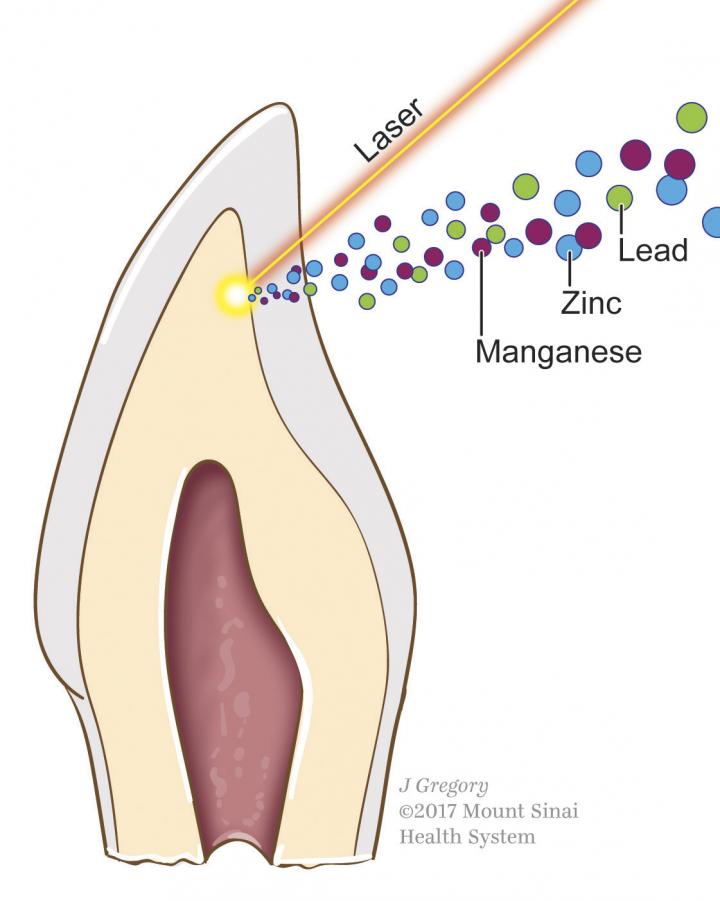![This is a cross-section of a tooth showing laser removal of the dentine layer, in tan, for analysis of metal content. [J. Gregory/Mount Sinai Health System]](https://genengnews.com/wp-content/uploads/2018/08/142058_web1665711976-1.jpg)
This is a cross-section of a tooth showing laser removal of the dentine layer, in tan, for analysis of metal content. [J. Gregory/Mount Sinai Health System]
Exposure to heavy metals, such as lead, mercury, and zinc, and the development of autism spectral disorder (ASD) has been a contentious relationship, to say the least. While the general scientific consensus is that the development of ASD is largely under the influence genetic mechanisms, there is substantial evidence to support that environmental exposure to various compounds has some association with the developmental disorder. Now, an international group of investigators led by scientists at Icahn School of Medicine at Mount Sinai and the Karolinska Institute has found that baby teeth from children with autism contain more toxic lead and less of the essential nutrients zinc and manganese, compared to teeth from children without autism.
Findings from the new study—published recently in Nature Communications in an article entitled “Fetal and Postnatal Metal Dysregulation in Autism”—suggest that differences in early-life exposure to metals, or more importantly how a child's body processes them, may affect the risk of autism.
“We think autism begins very early, most likely in the womb, and research suggests that our environment can increase a child's risk,” explained Cindy Lawler, Ph.D., head of the NIEHS Genes, Environment, and Health Branch who funded the study, but was not directly involved in the research. “But by the time children are diagnosed at age 3 or 4, it's hard to go back and know what the moms were exposed to. With baby teeth, we can actually do that.”
The research team observed higher levels of lead in children with autism throughout development, with the greatest disparity observed during the period following birth. Moreover, the team noticed lower uptake of manganese in children with autism, both before and after birth. Interestingly, the pattern was more complex for zinc, as children with autism had lower zinc levels earlier in the womb, but these levels then increased after birth, compared to children without autism. The researchers noted that replication in larger studies is needed to confirm the connection between metal uptake and autism.
Patterns of metal uptake were compared using teeth from 32 pairs of twins and 12 individual twins. The researchers compared patterns in twins where only one had autism, as well as in twins where both or neither had autism. Smaller differences in the patterns of metal uptake occurred when both twins had autism. Larger differences occurred in twins where only one sibling had autism.
We studied “monozygotic and dizygotic twins discordant for ASD to test whether fetal and postnatal metal dysregulation increases ASD risk,” the authors wrote. “Using validated tooth-matrix biomarkers, we estimate pre- and post-natal exposure profiles of essential and toxic elements. Significant divergences are apparent in metal uptake between ASD cases and their control siblings, but only during discrete developmental periods. Cases have reduced uptake of essential elements manganese and zinc, and higher uptake of the neurotoxin lead. Manganese and lead are also correlated with ASD severity and autistic traits.”
The researchers employed a method they developed previously that used naturally shed baby teeth to measure children's exposure to lead and other metals while in the womb and during early childhood. The scientists used lasers to extract precise layers of dentine, the hard substance beneath tooth enamel, for metal analysis. The team previously showed that the amount of lead in different layers of dentine corresponds to lead exposure during different developmental periods.
“What is needed is a window into our fetal life,” noted lead study investigator Manish Arora, Ph.D., an environmental scientist and dentist at the Icahn School of Medicine. “Unlike genes, our environment is constantly changing, and our body's response to environmental stressors not only depends on just how much we were exposed to but at what age we experienced that exposure.”
Prior studies relating toxic metals and essential nutrients to autism have faced key limitations, such as estimating exposure based on blood levels after autism diagnosis rather than before, or not being able to control for differences that could be due to genetic factors. This new method of using baby teeth to measure past exposure to metals also holds promise for other disorders, such as attention-deficit hyperactivity disorder.
“There is growing excitement about the potential of baby teeth as a rich record of a child's early life exposure to both helpful and harmful factors in the environment,” concluded David Balshaw, Ph.D., head of the NIEHS Exposure, Response, and Technology Branch and not directly involved in the current study.



